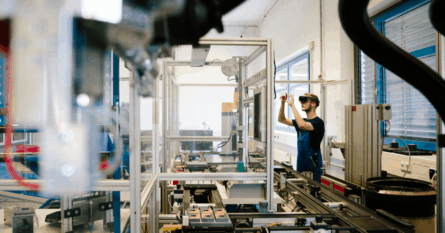Let’s take a look at the ways technology has significantly affected the way we travel the world.

According to the United Nations World Tourism Organization (UNWTO) World Tourism Barometer, international tourist arrivals totaled 1.4 billion in 2018, the second strongest year after 2017 since 2010.
With more travelers than ever, technology has certainly played a major role in the development of the industry, making it easier for people to travel for both business and leisure. Advanced technology has improved a range of sectors within the travel industry, from transportation and accommodation to communication and automation. Here’s a pick of some of the best improvements technology has made to our travel experiences so far.
The adoption of VR
Virtual reality has exploded in recent years, with the main draw coming from the gaming market. However, VR is starting to work its way into the travel industry thanks to its ability to completely transform a travel experience.
VR is becoming an effective tool for travel companies to let the consumer try before they buy. In 2015, U.K travel agency Thomas Cook, Samsung, and VR filmmakers Visualise collaborated to create a number of VR destination experiences. Visitors to Thomas Cook flagship stores in the U.K., Germany, and Belgium were invited to experience these holidaying experiences, which included a helicopter tour of Manhattan, and a walk along the OCBC Skyway in Singapore, via the Samsung Gear VR headset. This proved to be so successful it generated a 40 percent return on investment in the first three months alone, so expect more collaborations between VR tech and travel soon.

The AR experience
Many tourism companies, including hotels and airlines, have adapted augmented reality into their websites to help showcase their offerings more effectively.
This is proving to be quite a useful tool for tourism businesses and is less expensive than VR since it can be accessed by a tablet or smartphone. The Hub Hotel from Premier Inn, for example, uses wall maps in its rooms that guests can view through their device to be shown local places of interest. The same technology is also starting to be used more by restaurants and landmarks, allowing users to point their device and have the menu or history pulled up.
The rise of AI
Artificial Intelligence is taking off in 2019, with chatbots becoming frequently more used in the travel industry. Many hotels and flight companies around the world use messaging services for the benefit of their customers. Some have inbuilt chatbots on their own website and apps, while others use social media messaging services like Facebook Messenger and WhatsApp to communicate faster with their guests to provide better customer service.
Chatbots allow people to speak to another person or A.I. via a chat interface in an instant, without having to wait a long time for an email response or be stuck in a queue over the phone. Users can cover bases including check rates and availability, and even make the booking directly through the app. This kind of tech empowers both businesses and customers in the travel industry, helping them achieve a mutually beneficial outcome much quicker.
Breaking down language barriers
Once upon a time, foreign language phrase books were like bibles for a tourist in a new country, but not anymore. Technology has evolved to provide support when it comes to communicating with locals. Apps like Google Translate or iTranslate help travelers communicate much easier when abroad, thereby breaking down social and language barriers. Other apps, including Drops and Duolingo, allow travelers to freely learn or improve on a language in their own time and without having to spend money on classes.

Making payments safer and easier
Apple Pay, Samsung Pay, and Google Wallet are revolutionizing the way we pay for our travel experiences. Going cashless is proving to be highly advantageous for a couple of reasons. Firstly, it’s convenient because it means tourists don’t always need to carry large quantities of cash and cards or waste time queuing for the ATM. Secondly, it offers lower risk. Carrying cash can be burdensome for the traveler and a loss of cash is highly stressful.
Providing live data feeds on flights
Flight Global is the leading news and information website for aviation and thanks to Sabre Technologies, it provides worldwide live access to flight changes and up-to-the-millisecond flight schedules, which is a great advantage to frequent fliers. Meanwhile, for travel consumers, Skyscanner is the leading flight search engine that allows people to browse through quotes for flights by price, routes, dates and more.
Keeping us connected while flying
Wi-Fi onboard flights is widely becoming the norm, with a number of airlines already providing onboard services, including Emirates, JetBlue, Norwegian, Turkish Airlines, Air China, Philippine Airlines, Hong Kong Airlines, and Nok Air. Finnair, Srilankan Airlines, Kuwait Airways, TAAG Angola Airlines, and WestJet are just some of the latest airlines that have announced they’ll soon be implementing Wi-Fi onboard their own aircraft, providing more opportunities for passengers to stay connected with friends, family, and colleagues while they travel.
Easing congestion in airports
Busier airports around the world are now using Splunk Enterprise as a way to speed up the check-in and security process. Splunk is a software product that enables you to search, analyze, and visualize the data gathered from components of your IT infrastructure or business. Some airports are using this technology to figure out how to get passengers through security in five minutes or less and for detecting Wi-Fi spots around the airport where the service is slower to work out necessary improvements.
By 2020, Dubai Airport predicts it’ll increase to 100 million passengers annually. There’s no physical space to expand into, so they’re using big data analytics tools from Splunk to get those customers through the airport faster and smoother, including monitoring the archway metal detectors in security. These insights can help deliver more effective messaging to travelers (for example asking people to remove their shoes) to help free up staff.



